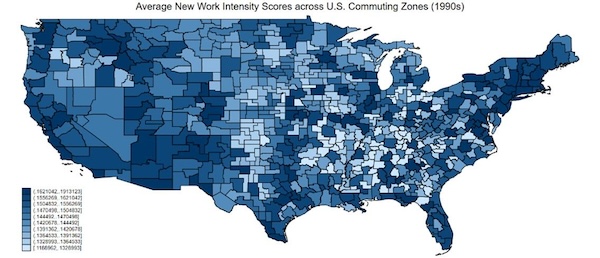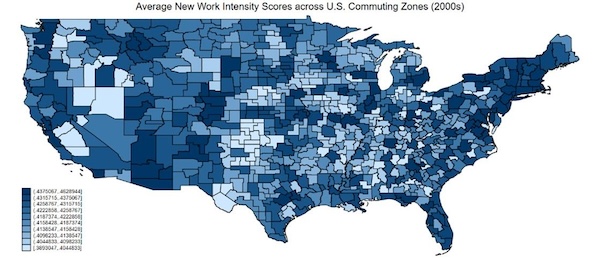Lambert here: Since you, readers, are geographically dispersed, I’d like to know if you hae anecdata to share on the thesis of this article. (Adding, the maps are that way in the original).
By Gueyon Kim, Assistant Professor at University of California, Santa Cruz, Cassandra Merritt, PhD candidate at University of California, Davis, and Giovanni Peri, C. Bryan Cameron Professor of Economics and Director of the Global Migration Center at University of California, Davis. Originally published at VoxEU.
The evolution and changing content of work is a defining feature of advanced economies. Jobs that did not exist in the US before 2000, for example, now employ millions of people. This column analyses the role of local factors and exposure to global shocks in generating ‘new work’. The findings point to the role of local human capital as a key element both in generating ‘new work’ as well as in turning some shocks, such as trade and technological change, into ‘new work’.
The evolution and changing content of work is a defining feature of advanced economies. The most advertised jobs in 1990 did not exist as job titles in the 1950s (Atalayt al. 2020) and 63% of employment in 2018 was performed in jobs that did not exist in the 1940s (Autor, Chin, Salomons, and Seegmiller, 2024). An economy’s capacity to create tasks and functions that culminate into distinctly new types of jobs – ‘new work’ – is crucial for maintaining employment and continued economic prosperity (Autor, 2015). Jobs described as “data warehouse architect”, “internet marketer”, “global supply chain director”, but also “life care planner”, “sommelier”, and “barista” did not exist in the US before 2000, and yet now they employ millions of people.
Recent literature has formalised the idea of changing content of work through two predominant approaches. Studies following the pioneering work of Autor et al. (2003) and Autor et al. (2008) consider shifts of employment between occupations characterised by different task or skill intensities. They suggest that work has shifted away from more routine tasks towards more non-routine cognitive, interpersonal, and analytical tasks. However, these studies mostly abstract away from changes in job definitions capturing more detailed job content. A second strand of literature has analysed the role of technologies in replacing a set of jobs while simultaneously creating opportunities for new jobs, where the intensity of these two phenomena, in the long run, determines the level of employment growth (Acemoglu and Restrepo 2019). However, this literature does not systematically analyse the role of local factors and exposure to global shocks (except technology) in generating ‘new work’.
In recent paper (Kim et al. 2024), we introduce a novel measure of ‘new work’ based on the introduction of new content in job titles to answer the following questions: Is it correlated to specific tasks, skills, and workers’ characteristics? Is ‘new work’ associated with employment growth? And what local factors and exposures to global shocks predict ‘new work?’ These are crucial questions to understand the recent evolution and future trends of US labour markets.
Measuring New Work as New content in Job Titles
Our innovative methodology contributes to the study of changing work by identifying ‘new work’ through semantic differences derived from natural language processing methods. In doing so, we build on the pioneering concept of ‘new work’ introduced by Lin (2011) that exploits additions to Census catalogues of job titles and we extend the application of semantic differences to detect ‘new work’ first innovated by Kim (2024).
At the core of our algorithm is text analysis that transforms job titles into high-dimensional vectors to compare semantic similarity. The vectors assigned by the ‘Continuous Bag of Words’ algorithm are based on the probability that words in a job title appear in similar contexts to words in another job title¬ – based on millions of training documents. ‘New’ in this context means ‘sufficiently distant (in meaning) from’ any job existing in a previous list. After additional technical steps that ground our notion of ‘sufficient distance’ in the quality of the source documents, our approach can be applied to identify ‘new work’ using any complete list describing the set of jobs and occupations in any economy over time. We apply this approach to identify ‘new work’ in each of 350 occupations codes in the US across the 1980s, 1990s, and 2000s.
Characteristics and Geography of New Work
Our first findings locate ‘new work’ across occupations and geography. We find that ‘new work’ has a strong positive correlation with years of schooling and the intensity of non-routine cognitive-analytical and manual-interpersonal tasks across occupations. We then transform our measure to capture its intensity across commuting zones in the US based on the local occupational distribution in the 1980s, 1990s, and 2000s. Figure 1 maps ‘new work’ intensity in the US in each decade and shows two features:
- A significant persistence in the geography of ‘new work’ over the decades (e.g. the coasts versus southern states)
- Urban areas experience the most ‘new work’ (including non-coastal cites such as Denver, Austin, and Chicago)
Across occupations, ‘new work’ is significantly and positively associated with greater employment growth, and this association is magnified across geography, suggesting a multiplier effect of ‘new work’.
Figure 1 Geography of ‘new work’
Panel A: 1980s
Panel B: 1990s

Panel C: 2000s

Notes: A darker shade represents greater ‘new work’ intensity in the commuting zone.
The Role of Global Shocks and Local Factors
We then turn the analysis to what predicts ‘new work’ across commuting zones between 1980 and 2010. We focus on two sets of economic considerations:
- Local exposure to global shocks: trade competition, new technologies (computerisation and robotisation), immigration, and ageing of local population
- The intensity of local factors (held fixed from 1980): population density, college educated share, manufacturing share of employment, and industrial diversity
Three sets of important findings emerge. First, the local share of college-educated population in the initial period is the most statistically significant and economically important positive predictor of ‘new work’ (Figure 2, left). High population density and a low share of manufacturing employment are the next most important predictors.
Second, exposure to global shocks as compared to local factors has weaker predictive power for ‘new work’ (Figure 2, right). Population ageing is the only shock with a strong average association with ‘new work’. In further analysis, we show that this is especially driven by the predicted share of retirees, suggesting a significant role for this group in stimulating demand for new services. Exposure to other global shocks, however, does not show significant correlations with ‘new work’ on average.
Third, the importance of some global shocks is revealed when allowing for heterogeneity across occupation types and locations. Exposure to technology has positive predictive power on ‘new work’ intensity specifically derived from occupations with high non-routine cognitive-analytical task intensity. This type of ‘new work’ is also more correlated with local human capital and population density. Additionally, exposure to trade shocks predicts ‘new work’ specifically in locations with high population density and a large share of college-educated population, which we call ‘high-skilled cities’. Outside of these ‘high-skilled cities’, highly educated immigration is associated with more ‘new work’, suggesting it is an important alternative source of human capital that associates with ‘new work’ where the human capital supply is otherwise low.
Figure 2 How Local Factors and Exposures to Global Shocks Predict ‘New Work’

Notes: Figure shows the increase or decrease in ‘new work’ intensity predicted by a one standard deviation change in the local factor (left) or exposure to global shock (right) shown over the 1980-2010 period.
Local Colleges and the Causal Role of Human Capital Supply
The set of predictions from our analysis highlights local human capital as a potentially crucial determinant in stimulating ‘new work’ and mediating the role of global shocks on the capacity of local labour markets to create ‘new work’. Therefore, we improve the identification of the causal role of the local human capital supply via an instrumental variable (IV) estimation. We isolate the supply-side effect of 1980 college share by exploiting the historical presence and density of local colleges, going back to the establishment of land grant colleges before 1920. The IV estimation finds a statistically and economically significant positive effect of human capital supply on local ‘new work’ intensities.
Our results highlight the quintessential importance of human capital supply for the creation of ‘new work’. The results suggest that high-skilled workers have comparative advantages in performing new tasks – part of which may be attributed to these local institutions being more adaptive to the evolving demands for skills – which facilitates the implementation and the diffusion of ‘new work’.
Conclusions and Research Avenues
The innovative measure of ‘new work’ in Kim et al. (2024) advances our understanding of how labour evolves. The algorithm and approach can be used to identify ‘new work’, based on the emergence of semantically different job titles, across other historical periods and in other countries that would further extend and generalise this analysis.
Our first analysis of local and global factors predicting ‘new work’ asserts the role of local human capital as a key element (Gagliardi et al. 2024) both in generating ‘new work’ as well as in turning some shocks (such as trade and technological change) into ‘new work’. Intriguingly, we also find that a growing retiree population associates with more ‘new work’, seemingly related to the demand of new services.
References available at the original.


